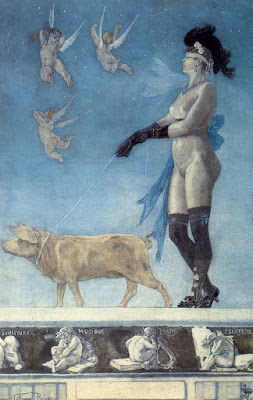Leonardo da Vinci painted two Madonnas set in caves. Why?
 |
|
Madonna of the Rocks, Leonardo da Vinci, c. 1483-86, courtesy of the Louvre.
|
We moderns are very good at seeing subconscious imagery in everything. In contrast, our ancestors communicated with universally-understood symbols. These represented an idea, a person, or even a relationship. Earlier this week, I came across a quotation from Leonardo da Vinci’snotebook, in which the distinction between symbol and subconscious gets a little fuzzy:
“Having wandered some distance among gloomy rocks, I came to the mouth of a great cavern, in front of which I stood some time, astonished,” he recalled. “Bending back and forth, I tried to see whether I could discover anything inside, but the darkness within prevented that. Suddenly there arose in me two contrary emotions, fear and desire—fear of the threatening dark cave, desire to see whether there were any marvelous thing within.”
 |
|
Madonna of the Rocks, c. 1503-06, Leonardo da Vinci, courtesy National Gallery
|
Leonardo painted two versions of The Madonna of the Rocks, twenty years apart. These are based on a legend of the time. The Holy Family, on the flight to Egypt, encounters a toddler John the Baptist, who then worships (adores) his savior cousin.
Artists before and after Leonardo regularly placed nativities in caves. This made historical sense, as Jesus’ birthplace was assumed to be the grotto under the Church of the Nativity in Bethlehem. (Natural caves were used as homes and barns in Bible-era Israel.)
Leonardo also painted St. Jerome in a cave, but everyone did that. Jerome translated his Bible into Latin in the cave where Jesus was born.
 |
|
St Jerome, c. 1480, unfinished, Leonardo da Vinci, courtesy the Vatican
|
But Leonardo stepped out into new territory when he painted his adoration scene. What did he mean by painting what is essentially an idyll framed by something he found terrifying?
Back to his own narrative. Desire won out over fear, and Leonardo entered the cave. He found a great, fossilized whale. “O mighty and once living instrument of formative nature. Incapable of availing thyself of thy vast strength thou hast to abandon a life of stillness and to obey the law which God and time gave to procreative nature…
“You lashed with swift, branching fins and forked tail, creating in the sea sudden tempests that buffeted and submerged ships. Now destroyed by time thou liest patiently in this confined space with bones stripped and bare; serving as a support and prop for the superimposed mountain.”
 |
|
Madonna of the Carnation, 1478, Leonardo da Vinci, courtesy Alte Pinakothek. Isn’t this just a more stylized version of the same traps and dark passages as in the cave paintings?
|
There are those who assume his maudlin meanderings are metaphorical, a sort of picture of what lies before us all. But Leonardo was more an earnest student of nature than a poet, and whale fossils are indeed found in Tuscany. Real or imagined, he read a lot into the experience.
 |
|
Apocalyptic scenes from da Vinci’s notebooks, c. 1517-18, Royal Collection Trust
|
Leonardo went on to describe the end of existence as we know it. “The rivers will be deprived of their waters, the earth will no longer put forth her greenery; the fields will no more be decked with waving corn; all the animals, finding no fresh grass for pasture, will die. In this way the fertile and fruitful earth will be forced to end with the element of fire; and then its surface will be left burnt up to cinder and this will be the end of all earthly nature.” He went on to illustrate these dark, apocalyptic scenes.
Biographer
Walter Isaacson described these pages as a sort of existential crisis. That’s a very modern mindset. I’d first be inclined to look for religious imagery—leviathan, Jonah and the whale, Resurrection, Revelation. Was he was setting the Adoration of the Christ Child against his own deepest fears, or those of the culture in which he lived?






















